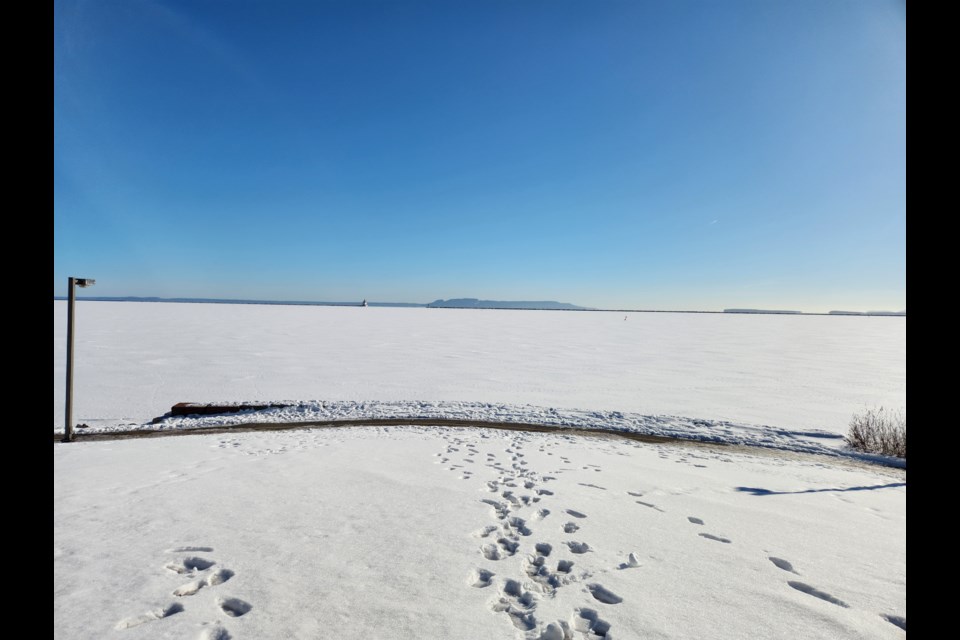THUNDER BAY, Ont. — Unless a protracted cold wave sets in, Lake Superior will likely set a new record this winter for lowest average amount of ice cover.
Data from the U.S. National Oceanic and Atmospheric Administration's Great Lakes Environmental Research Laboratory shows the average ice cover on the lake during the period Jan. 1 to Feb. 4 was only 3.2 per cent.
The previous record for the same period was reached in 2002, when 4.3 per cent of Lake Superior was covered in ice.
The historical average is 20.3 per cent.
A spokesperson for NOAA cautioned Monday in an email to TBnewswatch that "there's still a lot of winter left."
But Jay Austin, an expert on conditions on Lake Superior, said: "There have been eight years in the last 20 that have had ice around this level this time of year, so it's becoming much more frequent. I think the mildly unnerving aspect of this is that if you look prior to about 1998, we didn't really have these sort of low ice years."
Austin, a physics professor at the University of Minnesota Duluth with an appointment at the Large Lakes Observatory, attributed the trend mostly to human-induced climate change.
"We're changing the chemistry of the atmosphere. We end up trapping more heat. We have higher temperatures and we have less ice."
He said that on Lake Superior in particular, "One of the things that's worth keeping in mind is that the formation of ice is really, really sensitive to air temperature. And at some level, that's maybe not all that surprising. Cold years result in more ice. But the fact that the lake is as sensitive to small changes as it is, I think is pretty remarkable."
These changing conditions are sparking more and more speculation about the impact on the Great Lakes shipping season.
Chris Heikkinen, CEO of the Port of Thunder Bay offered his thoughts on the lack of ice.
"Most of the talk on the shipping side of the business is really about the upside of these decreased ice levels, and that really translates to longer seasons. There's certainly potential growth in the length of the shipping season moving forward if this trend continues, which it looks like it's likely to do."
Heikkinen said reduced ice coverage in the Great Lakes/St. Lawrence Seaway system has already impacted the season for ocean-going vessels.
"For the 'saltie' vessels, which account for about a quarter to a third of our ships, they actually did extend the season for those locks last year, and again this year. So there has been movement on that, and that does impact our port and how many shipments we can get in and out of the port."
A longer shipping season, he said, could have a "considerable" economic benefit for Thunder Bay.
"One of the biggest barriers to entry for shipping on this route and the seaway is that we're constrained to nine or 10 months a year. If you're a shipper, and you're looking to do regular shipping on a supply chain, a lot of those shippers want that consistent route for the full year. So there could be major upside if we did eventually get to a full year-round season."
Heikkinen acknowledged that lower ice levels might also have a detrimental impact on shipping.
"Less ice can lead to greater evaporation, and that means potential for lower water levels. Now the jury is still out on that. We can't predict with certainty, because there are all sorts of other factors. Greater precipitation is predicted for the Great Lakes as well, which could counterbalance that."
NOAA has stated that understanding the effect of ice on the Great Lakes is crucial because it affects a range of societal benefits provided by the lakes, not just with shipping but things such as hydropower generation and commercial fishing.
Austin emphasized that he's not an ecologist but added that ice provides essential protection for spawning fish in coastal zones and also acts as a kind of armour against coastal erosion during winter and spring storms.
"From my perspective as a physicist, one thing that I study is how ice cover on the lake sort of pre-conditions it for the following year . . . So a year like this where we have very little open-lake ice, we expect that there's going to be a relatively early start to summer, and we're going to see relatively warm water temperatures."
Unfortunately, warm water increases the likelihood of blue-green algae blooms forming on Lake Superior, including near Thunder Bay where they have already shown up in recent summers.
Austin has just returned from an International Joint Commission workshop focused on how Canada and the U.S. can improve their ability to observe the Great Lakes during the winter.
"We do a really poor job of understanding how the lakes work during the winter season . . . My concern is we probably should have done this 15 years ago, because I think that winter in the Great Lakes is really about to be fundamentally different."
Gary Rinne is a reporter for TBnewswatch.



